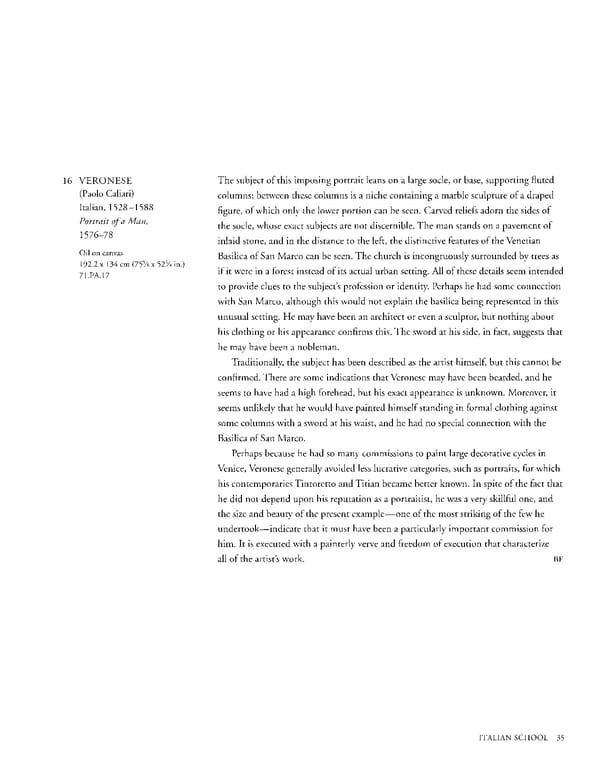16 VERONESE The subject of this imposing portrait leans on a large socle, or base, supporting fluted (Paolo Caliari) columns; between these columns is a niche containing a marble sculpture of a draped Italian, 1528-1588 figure, of which only the lower portion can be seen. Carved reliefs adorn the sides of Portrait of a Man, the socle, whose exact subjects are not discernible. The man stands on a pavement of 1576-78 inlaid stone, and in the distance to the left, the distinctive features of the Venetian Oil on canvas Basilica of San Marco can be seen. The church is incongruously surrounded by trees as 192.2 x 134 cm (75 x 52¾ in.) 71.PA.17 if it were in a forest instead of its actual urban setting. All of these details seem intended to provide clues to the subject's profession or identity. Perhaps he had some connection with San Marco, although this would not explain the basilica being represented in this unusual setting. He may have been an architect or even a sculptor, but nothing about his clothing or his appearance confirms this. The sword at his side, in fact, suggests that he may have been a nobleman. Traditionally, the subject has been described as the artist himself, but this cannot be confirmed. There are some indications that Veronese may have been bearded, and he seems to have had a high forehead, but his exact appearance is unknown. Moreover, it seems unlikely that he would have painted himself standing in formal clothing against some columns with a sword at his waist, and he had no special connection with the Basilica of San Marco. Perhaps because he had so many commissions to paint large decorative cycles in Venice, Veronese generally avoided less lucrative categories, such as portraits, for which his contemporaries Tintoretto and Titian became better known. In spite of the fact that he did not depend upon his reputation as a portraitist, he was a very skillful one, and the size and beauty of the present example—one of the most striking of the few he undertook—indicate that it must have been a particularly important commission for him. It is executed with a painterly verve and freedom of execution that characterize all of the artist's work. BF ITALIAN SCHOOL 35
 Masterpieces of the Getty Museum: Paintings Page 35 Page 37
Masterpieces of the Getty Museum: Paintings Page 35 Page 37